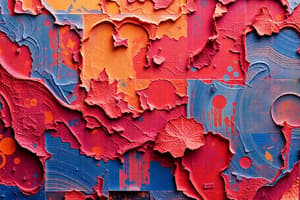Podcast
Questions and Answers
What is the most fundamental way to create an image according to the text?
What is the most fundamental way to create an image according to the text?
- Values
- Shapes
- Forms
- Lines (correct)
Which element of art refers to the three-dimensional aspect of an object?
Which element of art refers to the three-dimensional aspect of an object?
- Color
- Form (correct)
- Shape
- Value
Which element of art is used to create depth and contrast in a composition?
Which element of art is used to create depth and contrast in a composition?
- Value (correct)
- Color
- Shape
- Line
Which element of art is used to create mood, convey meaning, and attract attention?
Which element of art is used to create mood, convey meaning, and attract attention?
What is the relationship between objects, their surroundings, and the light source called?
What is the relationship between objects, their surroundings, and the light source called?
Which of the following is not one of the seven main elements of art mentioned in the text?
Which of the following is not one of the seven main elements of art mentioned in the text?
Which element of art is defined by its edges, angles, and the surrounding space?
Which element of art is defined by its edges, angles, and the surrounding space?
What is the purpose of understanding the elements of art according to the text?
What is the purpose of understanding the elements of art according to the text?
Which of the following is not a characteristic of lines mentioned in the text?
Which of the following is not a characteristic of lines mentioned in the text?
What aspect of form does the text mention?
What aspect of form does the text mention?
Flashcards are hidden until you start studying
Study Notes
Elements of Art
Understanding the elements of art is essential for anyone interested in visual arts, including painting, drawing, sculpture, photography, and other forms of creative expression. These fundamental principles guide artists in creating effective compositions, and they also serve as a vocabulary for art critics and viewers to analyze and appreciate works of art. The following are the seven main elements of art:
1. Line
Lines are the simplest way to create an image and convey movement and direction. They can be thick or thin, long or short, and curved or straight, and they can be used to create texture and contrast.
2. Shape
Shapes are defined by their edges, angles, and the surrounding space. They can be geometric or organic, and they can be used to create contrast, balance, and movement in a composition.
3. Form
Form is the three-dimensional aspect of an object, which includes its size, shape, and texture. It is the way objects appear to our eyes and is the result of the play of light and shadow.
4. Value
Value refers to the degree of lightness or darkness of a color, and it plays a significant role in creating depth and contrast in a composition. It is the relationship between objects, their surroundings, and the light source.
5. Color
Color is a fundamental element of art and refers to the hue, saturation, and brightness of a pigment or light. It is used to create mood, convey meaning, and attract attention.
6. Texture
Texture is the surface quality of an object, which can be rough or smooth, hard or soft, and it can be used to create contrast, depth, and interest in a composition.
7. Space
Space is the area around and between objects, and it is used to create depth, balance, and movement in a composition. It can be positive or negative space, and it can be used to create a sense of depth and perspective.
These elements of art work together to create a composition that is visually appealing and effective in conveying the artist's message or intent. Understanding these elements can help viewers appreciate and analyze works of art, and it can also inspire artists in their own creative endeavors.
Studying That Suits You
Use AI to generate personalized quizzes and flashcards to suit your learning preferences.



